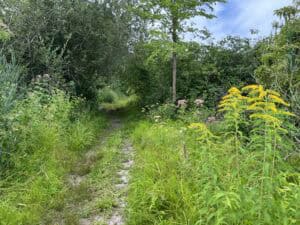
Channel 5 News reported on deer and problems with deer ticks in the Blue Hills. Here’s an excerpt from the article:
An area inside Blue Hills Reservation may look like nothing more than a bunch of dried out, broken plants, but Tom O’Shea of the Division of Wildlife and Fisheries said it’s been ravaged by an overpopulation of deer that feed on the vegetation.
“The forest loses the ability to regenerate itself, and a lot of younger forest might not regenerate and come up,” said O’Shea. Now the state’s Department of Conservation and Recreation, which owns Blue Hills, is considering a controlled hunting program to bring down the deer population. The Division of Fisheries and Wildlife is advising them.
The Department of Conservation and Recreation emphasizes they are only studying the possibility of deer hunting in and around Blue Hills. There are other solutions on the table, including fencing.
On the other hand, Sunday’s Boston Globe ran an article where ecologist Richard Ostfeld questions the effectiveness of reducing deer populations in controlling Lyme disease.
“I’m not ethically opposed to hunting deer at all,” says Ostfeld. “I would argue that deer are a public-health menace in the sense of car accidents, and I know as an ecologist that they can cause enormous damage to forest health. So there are a number of legitimate reasons for controlling deer populations. But the scientific evidence as I’ve reviewed it, without any preconceived notion or political agenda or any other agenda, does not support the notion that tick numbers and Lyme disease risk are strongly correlated with deer numbers, and the data do not suggest that if you manage deer by hunting, you’ll reduce the number of Lyme cases.”
Others in the article support reducing deer populations, but point out that it’s a long-term strategy. Sam Telford, a professor of biomedical sciences at the Cummings School, says there are no quick fixes:
“for people to believe that if they start doing something now they’ll see a return on their investment tomorrow is unwise. This thing took 30 years to develop, and it may take 10 years for any effects to be seen.”
The article continues with Telford’s thinking:
Reducing the deer population from 50 to 10 per square mile, research suggests, would lower the tick population by 80 percent within 10 years. “It’s not a linear effect, but a threshold effect.” And, Telford points out, no one has been able to study the impacts of open hunting as opposed to controlled kills, which measure pre- and post-hunt deer and tick counts, because of a lack of funding.
If one thing is clear in the muddled battle against Lyme disease, it’s that scientists – even those, like Telford, who support hunting as tick control – believe the approach must be multi-pronged and include efforts by homeowners and those who spend time outdoors to protect themselves.
To read the full article, click here.













Deer need a predator to keep their numbers down. When no predators exist, deer will overpopulate and denude a forest of it’s undergrowth. The deer will then starve. Generally an area can get enough archers to hunt deer with bow and arrow, which is safer, and totally quiet. Either have bow hunting or bring in wolves and cougars to be the top predators. Unfortunately, wolves and cougars hunt other things (humans, pets, livestock) as well.
Thanks for your comment. Since this post, there has been a study of deer populations in the Blue Hills: http://www.mass.gov/eea/docs/dcr/parks/south/blue-hills-deer-survey-report.pdf.